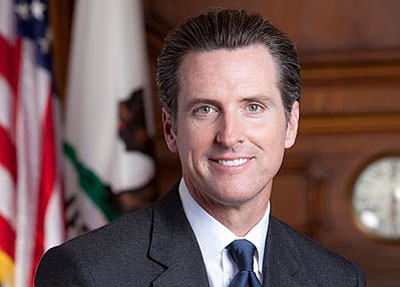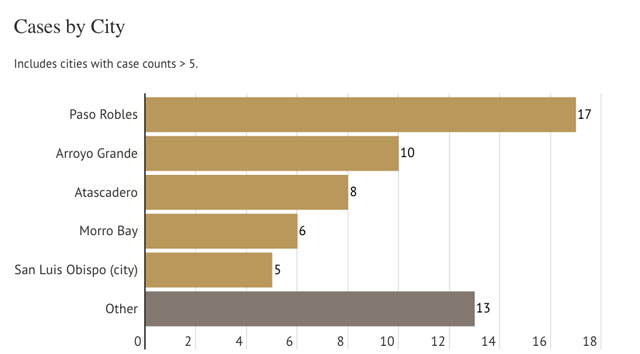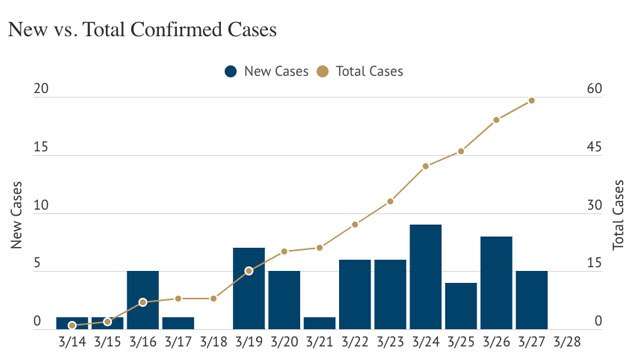COVID-19: SLO County reports 59 cases, releases city data
Click here for the latest March 28 update – COVID-19: SLO County reports 67 coronavirus cases
–On Friday, March 27, shortly after 1 p.m., the County of San Luis Obispo updated the community regarding the COVID-19 pandemic. At this time, 59 local residents have tested positive for the COVID-19 coronavirus. That’s five more cases than reported Thursday. The county reports that 11 local patients have now recovered from the virus, one is in an intensive care unit, six are hospitalized, and 41 are at home.
There are at least 3,801 cases in the State of California and 85,356 in the United States.
For the first time, the county reported on Friday more specific geographical detail on local cases.
- Paso Robles reported COVID-19 cases: 17
- Arroyo Grande reported COVID-19 cases: 10
- Atascadero reported COVID-19 cases: 8
- Morro Bay reported COVID-19 cases: 6
- City of San Luis Obispo reported COVID-19 cases: 5
- Other San Luis Obispo County reported COVID-19 cases: 13
Cases in North County are rising faster than other regions
There are now 29 cases of COVID-19 coronavirus in North San Luis Obispo County. That’s the highest level of any region in the county, and infections in North County are rising faster than other regions in the county. The new city data was released as the county held a press conference Thursday at 3:15 p.m. at the county’s Joint Information Center at 1133 Kansas Avenue, San Luis Obispo, Calif.
On Thursday, County Public Health Officer Dr. Penny Borenstein called Paso Robles a ‘high point’ in COVID-19 cases, however, she added Friday, “We don’t want people to be reacting as if there is a really big difference if your count is 17 versus 12 or five because the bottom line in this epidemic is that we have cases in virtually every area of our community and we anticipate seeing many more.”
Social distancing may not be lifted for some time
Borenstein said, based on her research, that she expects the “first wave” of infections to occur over six weeks to three months. It’s been two weeks since the first reported case.
The best chance to stop the virus will be a vaccine, she said, or that enough people in the community are infected and become immune. “We just need to be able to spread out the rate at which our community becomes infected,” she said, so that medical staff is not overwhelmed with cases.
“We are not going to be able to lift social distancing next week or the week after or probably for some time,” she said.
On Thursday the county announced closures to piers, beach parking lots, campgrounds, and parks. Friday the county announced that Cayucos Pier will also close. The county also moved to restrict visitors to health care facilities, and created a “Safe Parking” program for local homeless.
The county reports the first night of “Safe Parking” for homeless individuals and families was a success. Bathrooms, hand washing stations, and secured parking are available from 7 p.m. – 7 a.m. at the Los Osos Library. The county is working to identify additional sites for safe parking in the future.
On Wednesday, the county announced 46 cases; plans to create a field hospital at Cal Poly with 400-700 beds. Work is to begin on Monday with a scheduled opening date of April 8.
Borenstein this week called on volunteers to dramatically increase the county’s Medical Reserve Corps. She said that as of Friday, 85 people have volunteered.
The State of California announced a major financial relief package, including 90-day mortgage payment relief. On Tuesday, the county had reported 42 cases, SLO County Courts closed, and a CalPoly student tested positive.
In Paso Robles, the school district on Friday announced that schools will remain closed and that distance learning for students will start on Monday.
Stats from county, 1:30 p.m. March 27, 2020:
Distribution of COVID-19 cases in San Luis Obispo County
- North County cases – 29
- Coastal County cases – 11
- San Luis Obispo central cases – 5
- South County cases – 14
Ages of COVID-19 cases in San Luis Obispo County
- Age 0-17 years old – 3
- Age 18-49 years old – 23
- Age 50-64 – 15
- Age 65 years or older – 18
Cases of COVID-19 by status in San Luis Obispo County
- At home – 41
- Hospitalized – 5
- Hospitalized in intensive care – 2
- Recovered – 11
- Deaths – 0
Source of transmission of COVID-19 cases in San Luis Obispo County
- Travel related transmission – 24
- Known person-to-person transmission – 19 (most in households)
- Unknown community-acquired transmission – 6
- Unknown – 10
Cases of COVID-19 by testing laboratory
- SLO County Public Health Lab – 27
- Private labs – 32
Private labs doing testing include WestPac Labs, Quest Diagnostics, Pacific Diagnostic Laboratories, LabCorp, VRDL. As of Friday afternoon, the county reports conducting 348 COVID-19 tests. An unknown number of residents have been tested by private labs, the county reports.
Regional COVID-19 coronavirus cases
At 59 cases of COVID-19, San Luis Obispo County’s total is higher than its neighboring counties and much higher as a percentage of population. SLO County has more confirmed cases than any other county between San Jose and Los Angeles. Information at 1:30 p.m., March 27:
- Monterey County cases – 27 confirmed, 1 death, 403 tested
- San Benito County cases – 12 confirmed, 2 recovered, 1 death, testing not reported
- Fresno County cases – 27 confirmed, 325 tested
- Kings County cases – 1 confirmed, 85 tested
- Kern County cases – 34 confirmed, 1,602 tested
- Santa Barbara County cases – 32 confirmed, 8 recovered, 526 tested
- Ventura County cases – 61 confirmed, including 4 hospital workers, 1 death, 1,288 tested
- Los Angeles County cases – 1,465, 26 deaths, over 11,000 tested
Additional information from the State of California, County of San Luis Obispo, and other agencies:
County’s online hub connects residents, businesses with government services in one location
–Residents of San Luis Obispo County now have a one-stop-shop online that will connect them with the assistance they need to overcome hardships caused by the coronavirus disease 2019 (COVID-19) pandemic. The county today opened a Virtual Local Assistance Center on Readyslo.org.
“This is a stressful time for everybody and we want to make sure it’s as easy as possible to get the resources you need,” said County Emergency Services Director Wade Horton. “We want you to be able to put food on the table, get your driver’s license, take care of your mental health, apply for unemployment, find business resources, and more. We’ll continue to update these resources as the situation unfolds.”
In typical emergencies, the County would likely open Local Assistance Centers at various locations to connect people with services, assistance, benefits, mental health support, unemployment and more. However, in this COVID-19 pandemic, the County needs people to stay home. So it is taking our Local Assistance Center and putting it online.
The virtual Local Assistance Center includes resources and information related to:
- Housing
- Utilities
- County assistance programs such as
- CalFresh, Medi-Cal, CalWORKs and
- general assistance
- Unemployment
- Business
- Agriculture
- Finances
- Emergency childcare DMV services
- and more
COVID-19 in California by the numbers
The following numbers reflect information received by local health jurisdictions as of 2 p.m., March 26.
- 3,801 – Positive cases
- 78 – Deaths (including one non-California resident)
- 1,083 – Community-acquired cases
- 2,718 – Cases acquired through person-to-person transmission, travel (including cruise ship passengers), repatriation, or under investigation. This includes 42 health care workers.
Ages of all confirmed positive cases in California
- Age 0-17: 45 cases
- Age 18-49: 1,906 cases
- Age 50-64: 967 cases
- Age 65+: 847 cases
- Unknown: 36 cases
Gender of all confirmed positive cases in California
- Female: 1,608 cases
- Male: 2,074 cases
- Unknown: 47 cases
Testing in California
As of 2 p.m. on March 26, approximately 88,400 tests had been conducted in California. This includes the latest numbers California has received from commercial and private labs and the 22 state and county health labs that are currently testing. Commercial, provider and academic labs have increased testing capacity and are now reporting that data to the state. The biggest labs included in this count include Quest, LabCorp, Kaiser, University of California and Stanford.
At least 23,480 results have been received and another 65,000 are pending.

Calif. Gov. Gavin Newsom
Governor Statement on Federal Supplemental Stimulus Bill
–Governor Gavin Newsom issued the following statement on the federal supplemental stimulus bill passed Friday:
“The stimulus bill passed today will provide critical support for California to fight COVID-19 and strengthen our hospitals and health care system. It means an additional $600 a week in Unemployment Insurance for the many Californians who have already lost jobs and the many more who will during this crisis, provides emergency loans and grants to help small businesses and non-profits keep people employed, and it provides direct aid to state and local governments so that we can respond to this emergency and aid communities and families during this time.
“States and local governments are on the front lines of fighting this pandemic — scaling up the capacity of our health system, supporting first responders, providing food aid, and supporting workers as they seek to make ends meet amid massive job losses. State and local governments will need additional and flexible funding to ensure they can continue responding to this crisis and continue critical services. California businesses and residents will also need additional federal support to weather this economic storm. California will work closely with our federal partners for more help to ensure that Californians can quickly recover from the economic, health, and humanitarian impacts from COVID-19.”
Governor takes action to establish a statewide moratorium on evictions
–California Governor Gavin Newsom today issued an executive order banning the enforcement of eviction orders for renters affected by COVID-19 through May 31, 2020. The order prohibits landlords from evicting tenants for nonpayment of rent and prohibits enforcement of evictions by law enforcement or courts. It also requires tenants to declare in writing, no more than seven days after the rent comes due, that the tenant cannot pay all or part of their rent due to COVID-19.
The tenant would be required to retain documentation but not required to submit it to the landlord in advance. And the tenant would remain obligated to repay full rent in “a timely manner” and could still face eviction after the enforcement moratorium is lifted. The order takes effect immediately, and provides immediate relief to tenants for whom rent is due on April 1st.
Today’s action builds on Governor Newsom’s previous executive order authorizing local governments to halt evictions for renters impacted by the pandemic.
A copy of the Governor’s executive order can be found here.
Governor issues order on Judicial Council emergency authority
–On Friday, California Governor Gavin Newsom signed an executive order to enhance the authority of California’s Judicial Branch to take emergency action in the face of the COVID-19 crisis.
Specifically, the executive order empowers the Judicial Council and the Chief Justice of the California Supreme Court to take necessary action to be able to conduct business and continue to operate while responding to the COVID-19 pandemic. The order does not affect any existing court order or rule.
The order allows the Judicial Branch to allow for remote depositions in every case (the law had previously required that parties be deposed in person) and electronic service of process. Additionally, the order leaves the Judicial Branch discretion to make any modifications to legal practice and procedure it deems necessary in order to continue conducting business.
“Our courts need to continue to do their business for the sake of the law and public safety, and to the extent they are able to, and it is my responsibility to do everything I can to give the Judicial Council and the Chief Justice the flexibility they need to take actions to meet this moment,” said Governor Newsom.
The California Constitution establishes the Judicial Council as the supreme administrative and rulemaking body for California’s courts.
The Judicial Council, through the Chief Justice, has recently taken actions amid the COVID-19 outbreak, including suspending jury trials for the next 60 days and issuing other emergency court orders.
L.A. County closes beaches due to COVID-19
–Los Angeles County beaches and beach facilities were closed to the public Friday in an effort to stem the spread of COVID-19.
By order of the county health officer, all beaches, beach facilities and beach accessways will be closed through April 19, when the order expires. Department of Beaches and Harbors (DBH) crews began closing the beaches and amenities, including restrooms, Friday morning. The bike path that runs along the beach also was closed and will remain off-limits to cyclists.
Beach parking lots were closed earlier in the week and volleyball nets were removed to discourage gatherings on the beach. But as the number of COVID-19 cases in the Los Angeles area continues to surge, health officials determined full beach closures were necessary.
“As predicted, we are beginning to see a dramatic increase in diagnoses of COVID-19, and diagnosed cases have more than tripled in the last week,” said Third District Supervisor Sheila Kuehl, who represents Malibu and other coastal communities north of Marina del Rey. “Over the weeks to come, we very strongly urge everyone to take every possible step to stay out of harm’s way and avoid infecting other people. I ask every County resident to comply with the Safer at Home recommendations, including today’s health order to stay off of County beaches. Your cooperation could literally mean the difference between life and death for many County residents.”
The closures come after a weekend where tens of thousands of people flocked to the coast, ignoring the “Safer at Home” directive by gathering in large groups and not maintaining a social distance of 6 feet between each person.
What is the cause of COVID-19 transmission?
–Transmission of the COVID-19 virus appears to be caused by close and prolonged contact, Borenstein said. The greater the illness has affected someone, the more likely they are to transmit it to other people, she said. Asymptomatic transmission, if occurring at all, is a minor proportion of infections, she said. Airborne infection appears to be limited to someone infected who coughs or sneezes and vapor droplets may linger for a short period of time. But neither asymptomatic transmission nor airborne transmission appear to be a dominant means of transmission, she said. The virus does tend to transfer well with human contacts, like shaking hands, and linger on hard surfaces, studies have shown.
How people can protect themselves
Every person has a role to play. Protecting yourself and your family comes down to common sense:
- Staying home except for essential activities – “Shelter at home“
- Washing hands with soap and water for a minimum of 20 seconds.
- Avoiding touching eyes, nose or mouth with unwashed hands.
- Cover a cough or sneeze with your sleeve, or disposable tissue. Wash your hands afterward.
- Avoiding close contact with people who are sick.
- Staying away from work, school or other people if you become sick with respiratory symptoms like fever and cough.
- Practicing social distancing.
- Following guidance from public health officials.
What to do if you think you’re sick
Call ahead: If you are experiencing symptoms of COVID-19 (fever, cough or shortness of breath) and may have had contact with a person with COVID-19, or recently traveled to countries with apparent community spread, call your health care provider before seeking medical care so that appropriate precautions can be taken.
San Luis Obispo County’s urgent communicable disease line is (805) 781-4553.
- Follow all local COVID-19 coronavirus news updates
- San Luis Obispo County COVID-19 website – readyslo.org
Comments
Scott Brennan is the publisher of this newspaper and founder of Access Publishing. Follow him on Twitter, LinkedIn, or follow his blog.

























